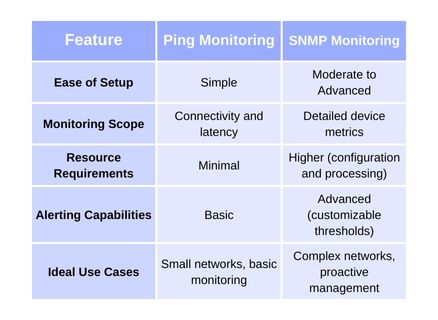Effective network monitoring is critical for ensuring smooth operations and maintaining reliable connectivity in today’s interconnected digital environments. Two of the most widely used monitoring methods—Ping and SNMP (Simple Network Management Protocol)—offer unique capabilities tailored to different aspects of network performance management. But how do you choose the right approach for your needs? In this article, we’ll explore the basics of Ping and SNMP monitoring, compare their advantages, and help you determine the optimal solution for your network. My Site Boost’s expertise in leveraging these methods ensures your network stays fast, reliable, and efficient.
Ping vs SNMP: Choosing the Right Network Monitoring Approach with My Site Boost
Iliya Timohin
2024-12-16

Ping vs SNMP: Choosing the Right Network Monitoring Approach with My Site Boost
Understanding the Basics: Ping and SNMP Explained
What is Ping?
Ping is a straightforward and widely recognized tool for monitoring network connectivity. It sends ICMP (Internet Control Message Protocol) echo requests to a target device and measures the time it takes to receive a response. If the device is unreachable or the response time exceeds expectations, Ping alerts the user to potential connectivity or latency issues.
Key Features of Ping Monitoring:
- Simple to set up and operate.
- Monitors basic connectivity and response times.
- Useful for detecting outages or slow connections.
What is SNMP?
SNMP (Simple Network Management Protocol) provides a more comprehensive approach to network monitoring. It gathers detailed information from network devices like routers, switches, servers, and more through a Management Information Base (MIB). This data includes metrics such as bandwidth usage, CPU load, memory status, and error rates, offering granular insights into the health and performance of your network.
Key Features of SNMP Monitoring:
- Collects detailed device metrics.
- Enables proactive monitoring through alerts and thresholds.
- Supports advanced troubleshooting and optimization efforts.
Performance Insights: How Ping Monitors Network Connectivity
Ping monitoring excels in its simplicity and reliability, making it an excellent tool for real-time monitoring of basic connectivity issues. My Site Boost leverages Ping-based monitoring to:
- Identify Connectivity Problems: Whether caused by hardware failures or ISP issues, Ping detects devices that are offline or unreachable.
- Monitor Latency: By tracking response times, Ping highlights performance bottlenecks and delays in your network.
- Ensure Reliability: Continuous Ping checks help maintain smooth operations by detecting problems before they escalate.
However, Ping’s scope is limited. While it’s a valuable tool for detecting outages, it doesn’t provide the deeper insights needed for comprehensive network performance management.
Comprehensive Control: What SNMP Brings to the Table
SNMP is the go-to method for organizations that require detailed network performance data. It offers:
- Device-Level Insights: With SNMP, you can monitor critical metrics such as bandwidth usage, error rates, and hardware status.
- Customizable Thresholds and Alerts: SNMP enables administrators to set thresholds for key metrics, triggering alerts when values deviate from the norm.
- Historical Data and Trend Analysis: By tracking and storing performance data over time, SNMP helps identify patterns and optimize resource allocation.
Despite its advantages, SNMP requires more configuration and expertise compared to Ping. For organizations with simple networks, SNMP’s complexity may outweigh its benefits.
Choosing the Right Approach: Ping, SNMP, or Both?
For most businesses, a hybrid approach that combines Ping’s simplicity with SNMP’s depth offers the best of both worlds. My Site Boost specializes in deploying tailored solutions that integrate these methods for optimal network performance.
When selecting a network monitoring method, consider your specific needs and resources. Here’s a comparison:

My Site Boost: Your Partner in Network Performance Monitoring
At My Site Boost, we understand that no two networks are alike. Our expertise in Ping-based monitoring ensures reliability and uptime by addressing critical connectivity concerns. For businesses requiring deeper insights, we also offer advanced SNMP configurations to deliver comprehensive network performance monitoring. With My Site Boost, you get:
- Customized Monitoring Solutions: Tailored to your network’s size, complexity, and objectives.
- Expertise in Optimization: From detecting outages to fine-tuning performance, we cover it all.
- Proven Reliability: Our clients trust us to keep their networks running smoothly, no matter the challenges.
Conclusion
Choosing between Ping and SNMP for network monitoring doesn’t have to be an either-or decision. By understanding the strengths and limitations of each method, you can implement a solution that meets your specific needs. Whether you’re troubleshooting connectivity issues with Ping or optimizing performance with SNMP, My Site Boost is here to help.
Contact us today to learn how we can enhance your network monitoring strategy and ensure peak performance for your business.
Ping vs SNMP: Choosing the Right Network Monitoring Approach with My Site Boost
Understanding the Basics: Ping and SNMP Explained
Performance Insights: How Ping Monitors Network Connectivity
Comprehensive Control: What SNMP Brings to the Table
Choosing the Right Approach: Ping, SNMP, or Both?
My Site Boost: Your Partner in Network Performance Monitoring
Conclusion